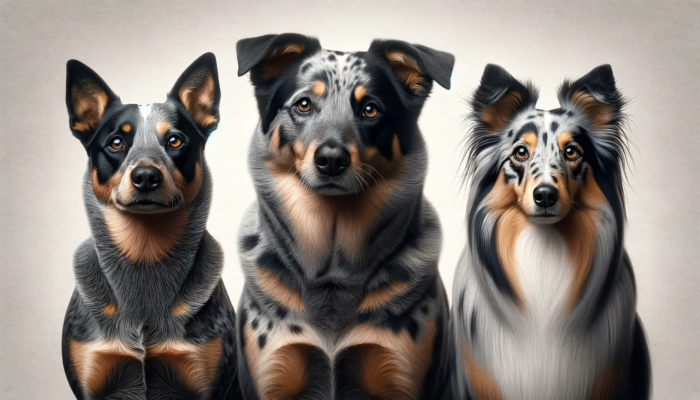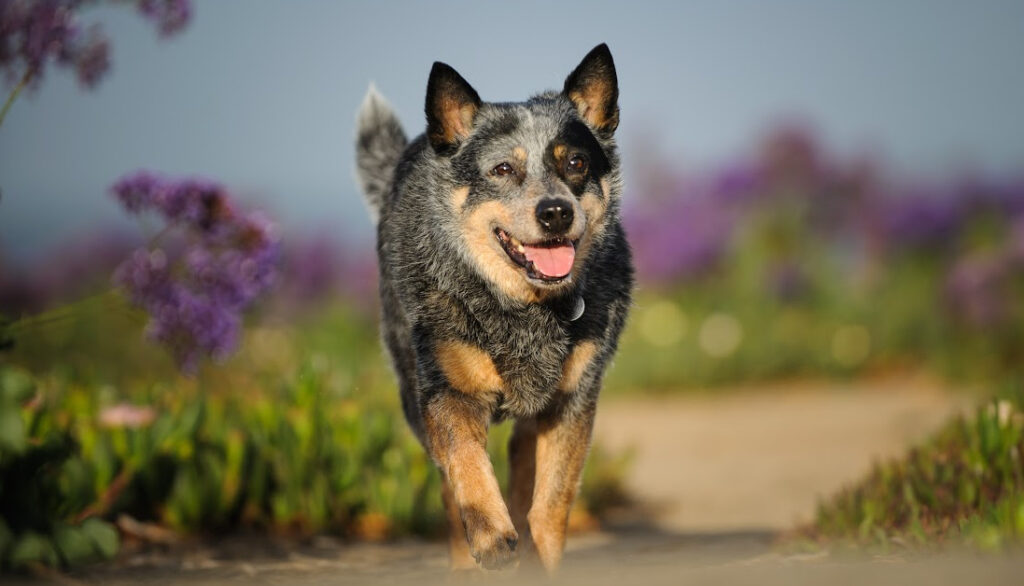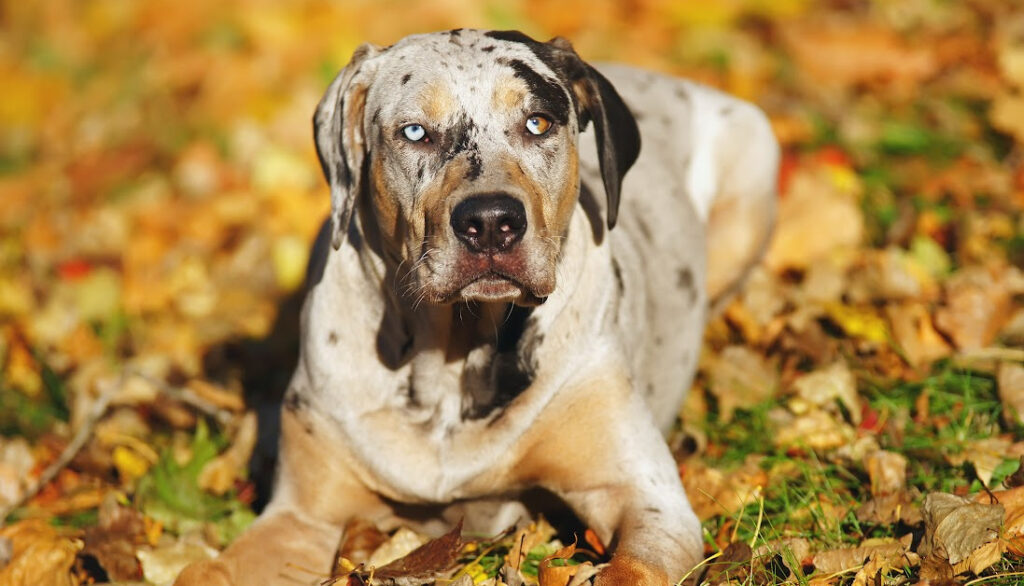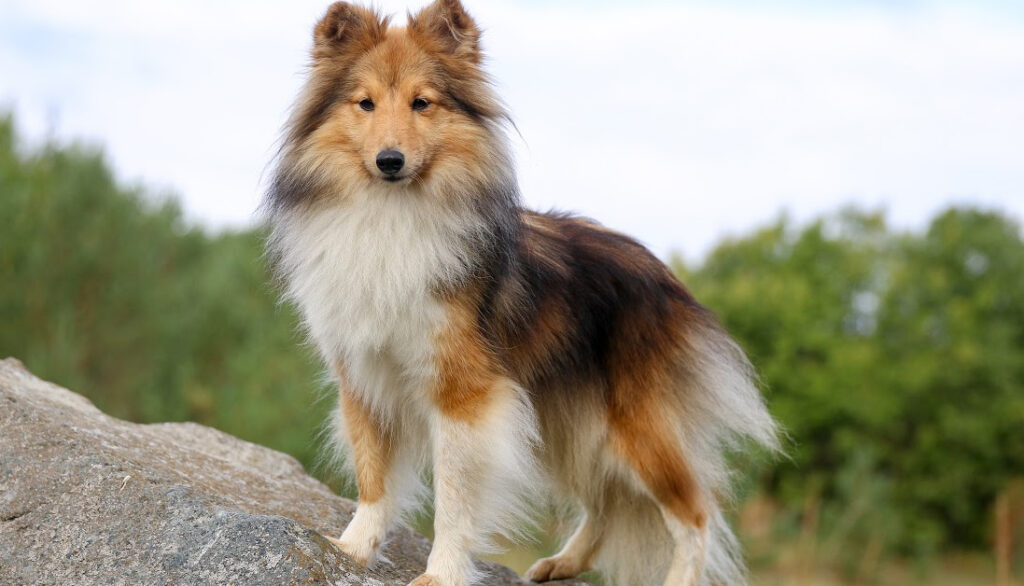Understanding Calico Patterns in Canines
When we think of the term ‘Calico’, our minds often wander to the realm of felines, where this tricolor pattern is quite prevalent. However, there’s a fascinating world of calico dog breeds that is equally captivating. Calico canines, unlike their feline counterparts, sport a distinctive blend of white, black, and brown hues, creating a charismatic mosaic that is hard to resist. The intriguing calico patterns in our canine companions are the result of a unique genetic dance that we’re about to dive into.

The Allure of Calico Coat Coloration in Dogs
What makes a calico coat so special? It’s the allure of a thousand stories woven into a unique tapestry of color. The calico coat is a fascinating mix of hues, a one-of-a-kind blend that sets these dogs apart from the rest. The unpredictable patterns of a calico coat make each dog unique, each fur telling its own individual story. The intrigue of calico dogs lies in their versatility – no two coats are exactly alike!
The Genetics Behind Calico Dogs
The intrigue of the calico pattern is not just skin deep. The science of tri-coloration in dogs is quite fascinating, taking us on a journey into the world of genes and chromosomes. Their calico patterns owe their existence to a unique interplay between certain genes which control color, pattern, and coat type. The blend of white, black, and brown is not just an artistic marvel but a testament to the power of nature and gene expression.
The Science of Tri-Coloration
The science of tri-coloration illuminates the incredible world of genetics, subtle nuances that paint our calico dog breeds with their characteristic hues. The three colors result from the combination of two pigment types: Eumelanin, responsible for the black and brown hues, and Pheomelanin, generating the lighter, yellowish tones. The white patches are areas where pigmentation is suppressed, creating a beautiful contrast that makes calico dogs stand out.
How Genes Influence Calico Patterns
The unique calico patterns in dogs are dictated by the genes they inherit from their parents. The primary genes influencing the calico pattern are the “S” gene, which controls spotting and white coloration, and the “A” gene, which determines distribution of other colors. These genes act like microscopic artists, painting each calico canine with a unique pattern that’s truly its own. It’s an intricate dance of genes that culminates in our beloved calico dogs!
Understanding the genetics and allure of calico dog breeds is the first step in appreciating these wonderful pets. The beauty of their unique coat is matched by their diverse personalities and breed characteristics. The world of calico dogs is truly a spectacle to behold – a testament to the captivating diversity of our four-legged friends.

The Genetics Behind Calico Dogs
Unlocking the mysteries of your beloved calico canine’s striking coat is a thrilling journey into the world of genetics. Just like an artist uses a palette to create a beautiful painting, nature uses genes to paint the unique calico pattern on your dog’s coat. Are you ready to learn how? Read on!
The Science of Tri-Coloration
The term ‘calico’ traditionally refers to a tri-color pattern seen in cats, but it’s also used to describe dogs with a similar pattern. Essentially, ‘calico’ dogs possess three distinct coat colors – typically white, black, and a reddish-brown. But what makes these colors come together in such a unique way?
The answer lies in the complex world of genetics. Dogs have two color genes: the ‘agouti’ gene, which determines the distribution of black and brown, and the ‘extension’ gene, which controls whether a dog will have black, brown, or yellow coat pigments. The interaction between these two genes determines a dog’s overall coat color.
In ‘calico’ dogs, there’s an additional factor at play – the white spotting gene. This gene affects the migration of pigment-producing cells during a puppy’s development, leading to areas of the coat where no pigment is deposited – resulting in white patches.
How Genes Influence Calico Patterns
You might be wondering, how can the same set of genes result in such a wide array of calico patterns? The answer can be compared to tossing a handful of confetti in the air – you can’t predict exactly where each piece will land, but you know it will create a beautiful, random pattern.
The white spotting gene behaves similarly. Depending on when during a puppy’s development the gene starts to influence cell migration, and to what degree, different calico patterns can emerge. This is why even within the same breed, no two calico dogs will have exactly the same pattern.
It’s important to note that while coat color genes are fascinating, they don’t influence a dog’s personality or health. So, whether your calico dog has more black or brown, or whether their white patches are big or small, they’ll still have the same lovable personality that makes them your perfect companion.
Genetics and Breeding Calico Dogs
Given the random nature of calico patterns, breeding for a specific look can be a bit of a genetic lottery. Not all puppies from parents with calico patterns will be calico themselves – it all depends on the genes they inherit from each parent.
If you’re interested in a dog with a calico coat, consider adopting from a breed known for this pattern, like the Australian Cattle Dog or the Louisiana Catahoula Leopard Dog. But remember, while their unique coat might catch your eye, it’s their personality that will truly win your heart.
So, as we delve deeper into the world of calico dog breeds, remember that their stunning coat is just the icing on the cake. As a dog parent, you’ll know that it’s their playful spirit, loving nature, and loyal companionship that truly makes them special.
Understanding the genetics behind your dog’s unique calico coat can deepen your appreciation for their natural beauty and the incredible diversity found within the canine world. It’s a testament to the magic of nature, and a delightful part of being a dog parent.
List of Calico Dog Breeds
When it comes to the world of dogs, variety is certainly not in short supply. From different sizes, shapes, and temperaments, to an endless array of color patterns, there’s something special for every dog lover. And among these, calico dog breeds stand as some of the most visually captivating. These breeds are cherished for their vibrant tri-colored coats, which typically feature a striking mix of white, black, and orange or tan hues.
Let’s take a closer look at two of these distinctive breeds:
Australian Cattle Dog: A Calico Canine
First on our list of calico dog breeds is the Australian Cattle Dog, a breed that is both energetic and intelligent. This breed is known for their hard-working spirit, attributed to their lineage as herding dogs. But perhaps their most distinctive feature is their beautiful calico coat.
The Australian Cattle Dog’s coat features a unique “ticked” pattern, where individual white hairs are intermingled with colored hairs, giving the dog a freckled or speckled appearance. This ticked pattern, combined with solid or mottled patches of black and tan, results in a stunning calico coat that is truly eye-catching.
Louisiana Catahoula Leopard Dog: The State Dog with Calico Coat
Next, we have the Louisiana Catahoula Leopard Dog, a breed as unique as its name suggests. This breed, which is actually the official state dog of Louisiana, is renowned for its striking coat that often comes in calico.
The Catahoula Leopard Dog’s coat is a sight to behold, with a mix of colors that can range from blue, gray, and black, to red, tan, and white. Often, these colors are muddled together in a merle pattern, presenting a calico-like effect. This breed’s distinctive coat, coupled with its penetrating, often mismatched eye colors, makes every Catahoula Leopard Dog a canine masterpiece.
Both the Australian Cattle Dog and the Louisiana Catahoula Leopard Dog are just two examples of calico dog breeds. Each breed is unique not only in their coat patterns but also in their temperament and personality, making each a wonderful choice for families and individuals alike.
It’s important to note, however, that while their calico coloration is certainly beautiful, it doesn’t necessarily define their character or behavior. Just like humans, each dog is an individual with their own unique traits and idiosyncrasies. Nonetheless, if you’re charmed by the calico pattern and are considering adding a canine companion to your home, both these breeds are worth considering!
Personality Traits of Calico Dog Breeds
When it comes to calico dog breeds, their vibrant tri-color coats are a marvel to behold. But their charm goes far beyond their striking patterns. Let’s delve into the behavioral traits and temperament of these unique canines.
Behavioral Characteristics of Tri-Colored Dogs
While each dog has its individual personality, certain behavioral traits seem to be commonplace in calico breeds. Here are some of the key characteristics:
– Intelligence: Many tri-color breeds, such as the Australian Cattle Dog, are known for their high intellect. They tend to be quick learners and thrive on mental stimulation.
– Energy: Calico dogs are often high-energy creatures, always on the go. They usually need plenty of exercise to keep them happy and healthy.
– Alertness: With a keen sense of awareness, calico breeds make excellent watchdogs. They are often attentive to their surroundings and quick to sound the alarm.
Calico Canines: Temperament and Compatibility
Bred for a variety of roles, calico dogs are versatile with varying temperaments. The Louisiana Catahoula Leopard Dog, for instance, is renowned for its fierce loyalty and protective nature. Meanwhile, the Australian Cattle Dog, another calico breed, is known for its tenacity and hard-working spirit.
Here are some common temperament traits in calico dogs:
– Loyalty: They tend to form strong bonds with their families and are often protective of their loved ones.
– Independence: Many calico breeds are known for their independent streak. They can be stubborn at times but are also capable of thinking on their feet and solving problems on their own.
– Social: With proper socialization, calico dogs usually get along well with other pets and people. They often appreciate companionship and can be quite friendly.
In terms of compatibility, calico dogs can fit into various households. However, given their high energy levels and intelligence, they are best suited to active families who can provide ample mental and physical stimulation.
Remember, these are general traits. Each calico dog will have its unique personality quirks and preferences. It’s important to get to know your calico companion and cater to their specific needs and personality traits.
To conclude, the calico dog breeds are not just about beautiful coats; they also bring a vibrant personality to the table. From their energetic nature to their loyal dispositions, these dogs can make a delightful addition to any family.

Grooming Needs of Calico Dogs
Calico dog breeds are as diverse as their beautiful coat patterns. Therefore, their grooming needs can vary significantly. Regardless of the breed, all calico dogs require regular grooming to maintain the health and vibrancy of their unique coats.
Brushing
Regular brushing is a must for calico dogs. It helps to remove loose hair, prevent matting, and distribute natural oils throughout the coat, promoting a healthy shine. Depending on the breed and coat type, brushing should be done at least once a week. Breeds with longer hair may require daily brushing.
Bathing
Bathing a calico dog should be done as needed, usually every one to two months. Over-bathing can strip the coat of its natural oils, leading to dry skin and a dull coat. Use a high-quality dog shampoo that is gentle on the skin.
Professional Grooming
Some calico breeds, such as the Australian Cattle Dog, have a double coat that may benefit from professional grooming, especially during shedding seasons. A professional groomer can also trim nails, clean ears, and provide other grooming services that can be challenging at home.
Health Considerations for Calico Breeds
While the calico pattern itself doesn’t directly influence a dog’s health, each breed has its own set of potential health concerns to be aware of. Here are some general health considerations for calico breeds:
Genetic Health Issues
All dog breeds have potential genetic health issues. For example, the Australian Cattle Dog is prone to hip dysplasia and progressive retinal atrophy, while the Louisiana Catahoula Leopard Dog can suffer from deafness and hip dysplasia.
Coat and Skin Health
The unique calico coat requires special attention to maintain its health. Regular grooming can help prevent skin issues like dermatitis and parasites. Also, calico dogs with lighter skin pigmentation are more prone to sunburn, so it’s important to provide shade or use dog-safe sunscreen during peak sun hours.
Regular Veterinary Care
Regular vet check-ups are crucial for all dogs, including calico breeds. Routine examinations can help detect potential health issues early and provide preventative care. Vaccinations, heartworm prevention, and regular dental check-ups are all important aspects of veterinary care.
Diet and Exercise
A balanced diet and regular exercise are essential for the overall health of calico dog breeds. These dogs can be quite active and require a diet that supports their energy levels. Regular walks, playtime, and mental stimulation are all important for their overall wellbeing.
In conclusion, owning a calico dog breed can be a rewarding experience. With their unique coat patterns and delightful personalities, these dogs certainly stand out in a crowd. However, it’s important to remember that they also have specific grooming and health needs that require commitment and care. With the right approach, you can ensure your calico canine companion stays healthy and happy.
Training and Socialization for Calico Dog Breeds
Training your calico dog breed can be a rewarding experience. These dogs are generally known for their intelligence, agility and eagerness to please, which makes them good learners. However, each breed and individual dog will have their own unique strengths and challenges. Here are some effective training techniques for tri-colored dogs:
- Positive Reinforcement: This is a widely-accepted training method that rewards good behavior with treats, praise, or playtime. Calico dog breeds, like the Australian Cattle Dog, respond well to this method as it reinforces their natural desire to please.
- Consistency: Dogs learn through repetition and consistency. Stick to the same commands and follow through with rewards or corrections every time.
- Puppy Classes: Enrollment in puppy classes can provide a structured environment for learning basic commands. Plus, your calico pup will have the chance to socialize with other dogs.
Socialization Strategies for Calico Canines
Socialization is equally important as training for your calico dog breed. It’s a process where your pup learns how to interact properly with other dogs, humans, and various environments. An under-socialized dog may exhibit fear, aggression, or anxiety. Here are some strategies for socializing your calico canine:
- Puppy Playdates: Organizing playdates with other vaccinated puppies or well-behaved adult dogs can offer your pup an opportunity to learn manners and social cues.
- Exploring Different Environments: Expose your calico dog to different environments—like parks, busy streets, or pet-friendly stores. This can help them become comfortable with various sights, sounds, and smells.
- Positive Experiences: Ensure all socialization experiences are positive. You can do this by pairing new experiences with treats or favorite toys. This will help your dog associate new situations with positive outcomes.
Training and socialization are key to raising a happy, well-adjusted calico dog. It’s always recommended to start early and be consistent. Remember, every dog is an individual, and what works for one may not work for another. Keep an open mind, stay patient, and don’t hesitate to seek professional help if needed. By investing time and effort into training and socialization, you’ll help your calico companion become a well-behaved and sociable member of the canine community.

Calico Dogs in Folklore and Myth
The allure of calico dogs extends beyond their striking appearance. In various cultures around the world, these tri-colored canines hold a special place in folklore and myth. Their unique coat patterns have been associated with good luck, mystique, and, in some instances, supernatural abilities.
For instance, in Native American mythology, the Louisiana Catahoula Leopard Dog, a breed known for their calico-like coat, was believed to have supernatural sight and the ability to see unseen dangers. These dogs were highly revered and thus, often used in hunting expeditions. Their unique coat was seen as a sign of their mystical powers, setting them apart from other breeds.
Similarly, in Australian folklore, Australian Cattle Dogs, another breed that occasionally displays a calico pattern, were often depicted as loyal companions to the indigenous people. They were believed to possess extraordinary strength and resilience, mirroring the rugged beauty of the Australian outback, making them a popular symbol within the culture.
The Role of Calico Dogs in Modern Society
Today, the role of calico dogs in modern society is more practical but no less important. While they may not be given supernatural powers, calico dog breeds have unique traits and characteristics that make them valuable and cherished members of society.
One popular calico breed, the Australian Cattle Dog, is particularly known for its hard-working nature and intelligence. Often employed as herding dogs, they are instrumental in managing livestock and thus play an integral role in agricultural societies. Their striking calico coats are not only visually appealing but also serve functional purposes, providing some camouflage in the outback.
On the other hand, the Louisiana Catahoula Leopard Dog is recognized as the state dog of Louisiana. These dogs are treasured for their tracking abilities, used for hunting game like wild boar. In addition, they are also known for their roles as search and rescue dogs, helping to locate lost persons and save lives. Their unique calico coats are a symbol of their heritage and are widely celebrated within the state.
Beyond their working roles, calico dogs also make excellent companions. Their unique coat patterns make them stand out in a crowd, and their storied cultural histories add an extra layer of intrigue. Whether it’s the loyal Australian Cattle Dog or the multi-talented Louisiana Catahoula Leopard Dog, calico dog breeds bring a touch of color and a dash of history into our lives.
In conclusion, the significance of calico dog breeds extends beyond their striking coloration. These dogs hold a special place in various cultures’ folklore and have unique roles in modern society. Whether you’re drawn to their mystique or their practical abilities, one thing is for sure: calico dog breeds make for fascinating, devoted companions.
Where to Find Calico Dog Breeds for Adoption
So you’ve fallen head over heels for the captivating patterns and lively personalities of Calico dogs. You’re not alone. Calico dogs have a history of captivating hearts across various cultures. These unique pooches are known for their distinctive tricolor fur and affectionate temperaments. If you’ve decided to add a Calico breed to your family, let’s talk about where to find these amazing dogs for adoption.
Begin your search by checking local animal shelters or rescue groups. Many of these organizations rescue all breeds, including Calico dog breeds. Websites like Petfinder and Adopt-a-Pet can also be valuable resources. You can filter your search based on breed, size, age, and location. Don’t forget to check specific breed rescue groups as well. The Australian Cattle Dog Rescue Association and Catahoula Leopard Dog Rescue groups often have Calico dogs available for adoption.
Remember, adopting a dog is a lifelong commitment. You’re not just bringing home a pet; you’re welcoming a new family member. Before adopting, make sure you’re ready to provide a loving home for your Calico dog for the entirety of their life.
Preparing Your Home for a Calico Canine
Once you’ve found your perfect Calico companion, it’s time to prep your home. These breeds are notorious for their energy and intelligence. They love to explore and play, so your home needs to be a safe and stimulating environment for them.
Here are some tips to help you prepare:
- Puppy proof your home: Just like babies, puppies love to explore everything with their mouths. Make sure to keep dangerous items like cords, chemicals, and small objects out of their reach.
- Provide plenty of toys: Calico breeds are intelligent and active dogs. Make sure to have a good selection of toys to keep them entertained. Puzzle toys can be great for mental stimulation.
- Set up a quiet space: All dogs need a quiet and safe place to retreat to when they’re feeling overwhelmed. Consider a comfy bed in a quiet corner, or a crate if they’re crate trained.
Welcoming a Calico dog into your home is a rewarding experience. Their unique patterns, engaging personalities, and loving nature make them a perfect family addition. Enjoy the journey, and remember, with love, patience, and understanding, you and your new Calico canine will forge a bond like no other.
Final Thoughts on Calico Dog Breeds
There’s something undeniably enchanting about the unique patterns and lively personalities of Calico dogs. Whether it’s the bold and courageous Australian Cattle Dog or the versatile and agile Louisiana Catahoula Leopard Dog, these breeds bring a splash of color and a whole lot of love into our lives.
Now that you’re prepared and ready, it’s time to make that special connection. May your journey to adopting a Calico dog breed be filled with joy and excitement. Just imagine the love and companionship your new furry family member will bring. Here’s to a lifetime of tail wags, face licks, and the irreplaceable bond that only a dog can offer.
Frequently Asked Questions
Q1: What is a Calico Dog?
A: A Calico Dog is not a breed but a color pattern that can occur in many different breeds. The term “Calico” is often used to describe cats, but it can also refer to dogs. Calico dogs have three colors in their coats: white, black, and an orange or reddish color.
Q2: What breeds can have Calico patterns?
A: Many breeds can have Calico patterns. Some of the most common include the Australian Shepherd, Border Collie, and Shetland Sheepdog. However, it’s important to note that not all individuals within these breeds will have Calico patterns.
Q3: Do Calico Dogs have unique personalities?
A: The personality of a dog is more influenced by its breed and individual temperament than its color pattern. However, some people believe that Calico dogs are particularly intelligent and energetic.
Q4: Are Calico Dogs rare?
A: Calico Dogs are not necessarily rare, but the pattern is less common in dogs than in cats. The exact frequency of Calico patterns in dogs is not known.
Q5: How do I care for a Calico Dog?
A: Caring for a Calico Dog is the same as caring for any other dog. They need a balanced diet, regular exercise, and regular vet check-ups. The color of their coat does not affect their health or care needs.
Dr. Candy, a holistic veterinarian and certified raw dog food nutrition specialist, graduated from Oklahoma State University in 2009 with a DVM and has since specialized in companion animal nutrition, advocating for species-specific diets. With a background in wildlife rehabilitation and oil spill response, she combines holistic health and conventional medicine in her unique approach to treating chronic diseases, allergies, and autoimmune conditions in pets. As the owner of a veterinary practice in Colorado and an author, Dr. Candy is dedicated to educating pet parents and improving the health and happiness of animals.




